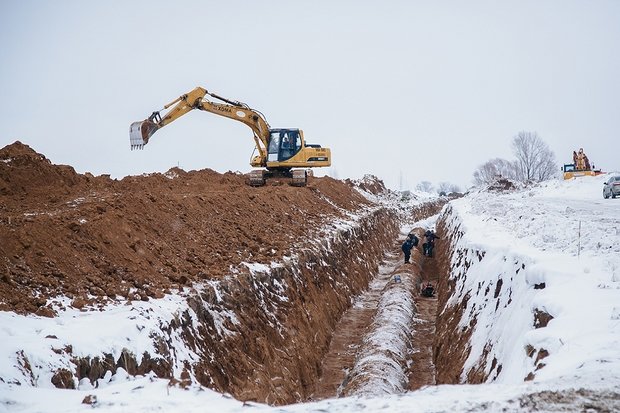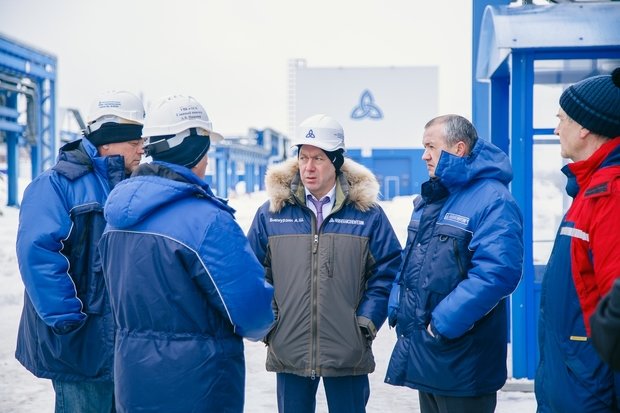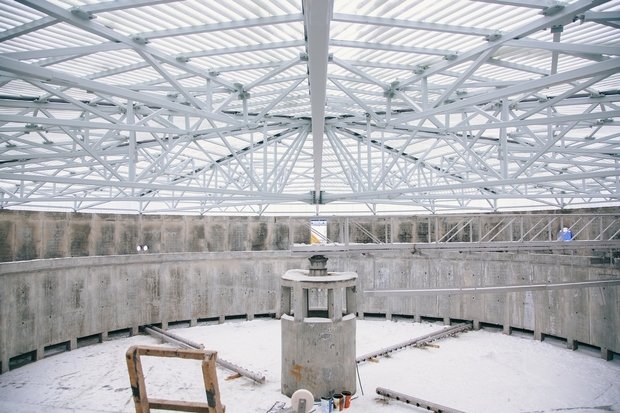Azat Bikmurzin on tank’s construction: ''It’s a unique job done in operating factories''
NKNK is going to allocate 1,5bn rubles to build a new tank, the works have begun and they plan to be completed by late 2019. The project is fulfilled simultaneously with the modernisation of biological treatment facilities – Nizhnekamskneftekhim Director General Azat Bikmurzin who regularly goes to the construction sites supervises the works. The details are in the piece.
''Ecological indicators and safety will improve, as the risk that sewage will end up in the soil and water bodies is excluded''
Specialists began the construction of a new tank for chemically contaminated wastewater (CCWT-3) in January. It's an additional branch along which flows from the industrial zone will go to the biological treatment facilities. It is constructed because of the Nizhnekamsk Industrial Hub's active development and, as a consequence, a high load on the currently operating tank (CCWT-2). For this reason, officials of the enterprise made a decision to build another line. It will allow to not only increase the capacity but also augment safety when transporting sewage from the industrial site.
''Ecological indicators and safety will improve, as the risk that sewage will end up in the soil and water bodies as well as unpleasant smells into the atmosphere is excluded. The tank will have biofilters to purify the air,'' said deputy director of the shop No. 3406 of Nizhnekamskneftekhim's Water Supply, Sewerage and Wastewater Treatment Administration Rustam Akhmetshin.

A unique microtunnelling technology was chosen to lay the tank in deep areas and at crossings with communications. This method reduces the environmental impact to a minimum, as it doesn't require digging a trench along the tank. Pipes are laid up to 16 metres underground thanks to horizontal drilling. Builders simultaneously erect cameras through which the drilling rig will lay the pipeline. Eight out of 66 cameras for microtunnelling are already ready.
''It's a unique job because it's done in operating factories, and assembly works are done almost 15-20 metres underground along 3,5 km by horizontal drilling with the use of unique equipment. And we plan we will complete this work by the end of the year, consequently, we will have another additional reserve tank, which will allow to increase production safety, first of all, and, of course, improve ecological parameters of our sewage,'' Nizhnekamskneftekhim Director General Azat Bikmurzin explained.

The tank will be 15 km in length, of which 3 km towards the industrial zone will be laid in a ''closed'' way –it's where the tank is deep enough and crosses with underground mains, railways and roads. The main part of the tank will be laid in an open, cut-and-cover way. The work on it began near the biological treatment facilities.
''We are going to launch the unit in April-May and start to arrange the regime'' in biological treatment facilities
All sewage in the tank will go the biological treatment facilities where the second stage of reconstruction of the hub of chemically contaminated wastewater mechanical treatment is underway. Most of the works on the mains have been completed now, the principal equipment has been assembled, preaerators are 60% ready.
''We are keeping to the schedule. Consequently, all works are done on time, with due quality. We plan to launch the unit in April-May and start to arrange the regime. And we will also control all the questions that will arise,'' Nizhnekamskneftekhim PJSC Director General Azat Bikmurzin commented.
Chemical sewages from Nizhnekamskneftekhim and the rest of the industrial zone go to this hub – it's about 70 enterprises in total. Due to chemical contaminants, sewage contains a lot of volatile organic compounds, which evaporate and emit an unpleasant smell. For this reason, when modernising the BTF, a new treatment technology was chosen to not only increase the quality of sewage treatment but also reduce the load on the atmosphere. As a result, specialists chose biofiltration, which is considered one of the best in Europe.
''After pilot tests, which lasted throughout 2018, a system of biofilters allowing to treat emissions to the atmosphere from the primary sites of chemical wastewater treatment with up to 95% of efficiency,'' noted deputy chief engineer at Nizhnekamskneftekhim on environmental protection Andrey Rubezhov.
Four preaerators were built in the biological treatment facilities for this technology – it's round facilities where gases will be separated from sewage.

''About 90% of hydrocarbons coming with sewage are expected to be aerated. All volatile compounds in sewage will be collected by aerating and sent to biofilters by gas glows. Special microorganisms will neutralise them there: they will decompose ''strong smells'' into water and carbon dioxide. So the smells will be neutralised, and only then gases will be emitted into the atmosphere. All this gas treatment system is hermetic, this is why odorous substances can't go into the air,'' Andrey Rubezhov went on.
NKNK took ecological measures at over 5bn rubles for 4 years
The reconstruction of biological treatment facilities and the construction of the tank are included in the fourth ecological programme Nizhnekamskneftekhim has been implementing from 2014 to 2020. 346 measures assessed at over 5bn rubles were taken only from 2014 to 2018.
''Residents of Alan village were resettled, for this purpose, the company sent 107,6m rubles. The buffer pond in the Tungucha River was treated where 67,400 tonnes of sludge was raised and dehydrated – the costs totalled 106,5m rubles. The first reconstruction stage of biological treatment facilities was completed, whose capital costs made up 518,57m rubles. 10 cooling towers were also reconstructed, which allowed to save energy consumption by 13,87m kWh a year. The costs were equal to 525,7m rubles. Over 100 measures were taken in factories to reduce emissions of polluting substances into the atmosphere,'' told deputy chief engineer at Nizhnekamskneftekhim on environmental protection Andrey Rubezhov.
Compared to 2017, in 2018, the concentration of iron in the treated sewage after biological treating decreased by 19%, aluminium – by 16%, sulphate – by 17%, suspended substances – by 21%, phenol – by 35%, surfactants – by 45%, formaldehyde – by 52% and methanol – by 71%. Although the enterprise increases production output, the harmful environmental impact reduces. NKNK has decreased the intake of river water by 1m 75,000 cubic metres and reduced emissions of harmful substances into the atmosphere by 2,733 tonnes since 2014.